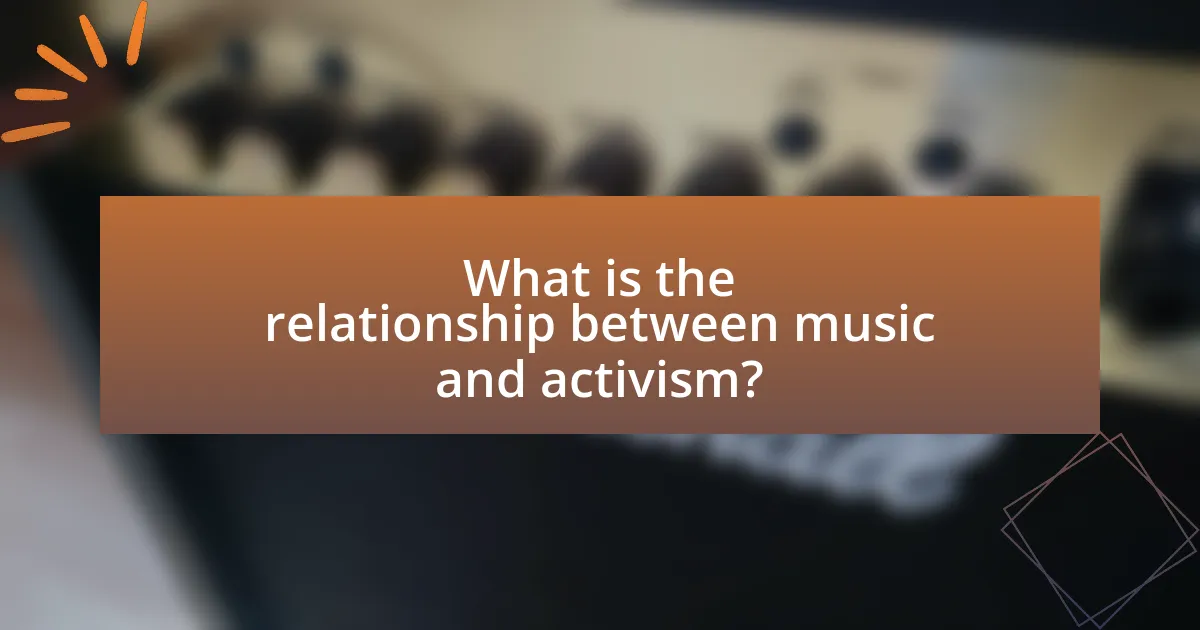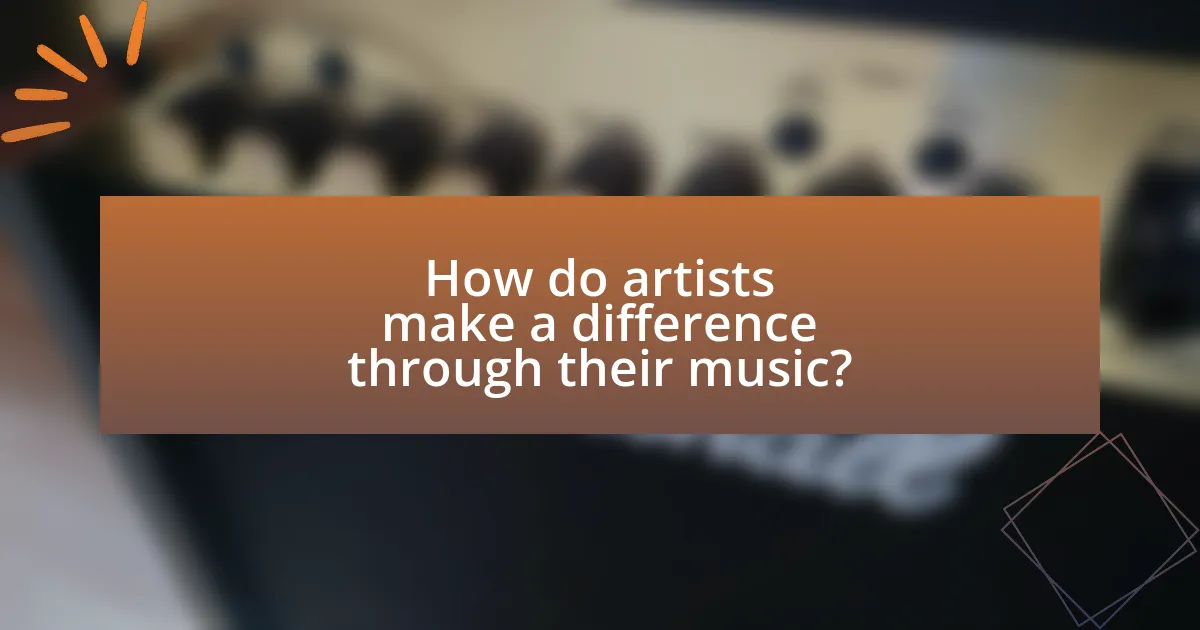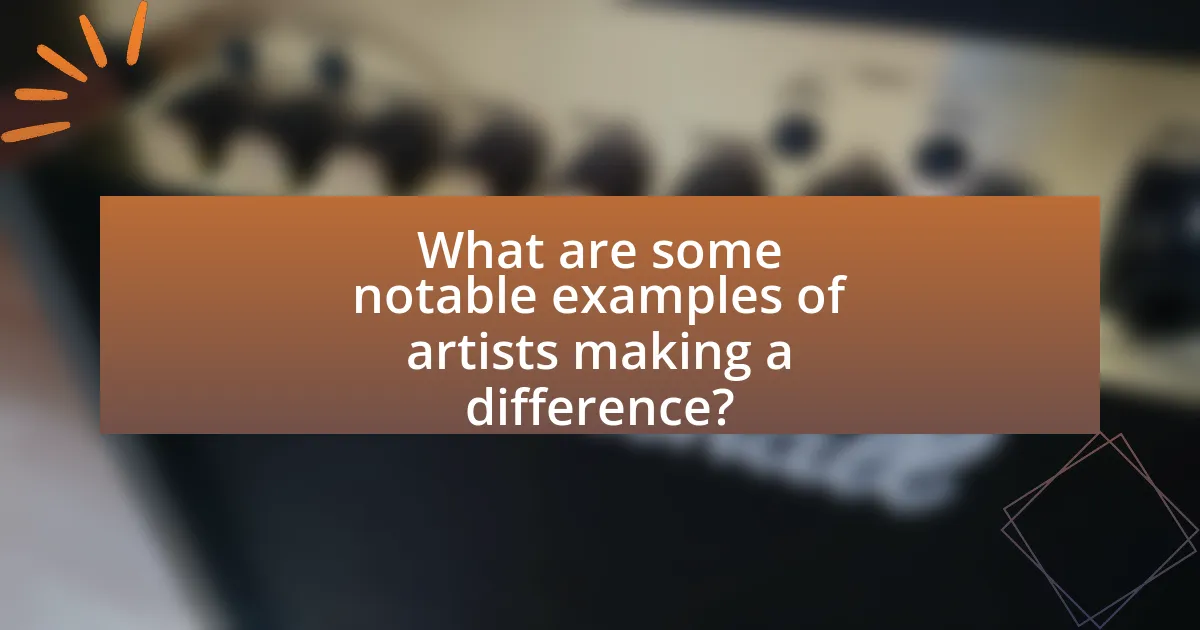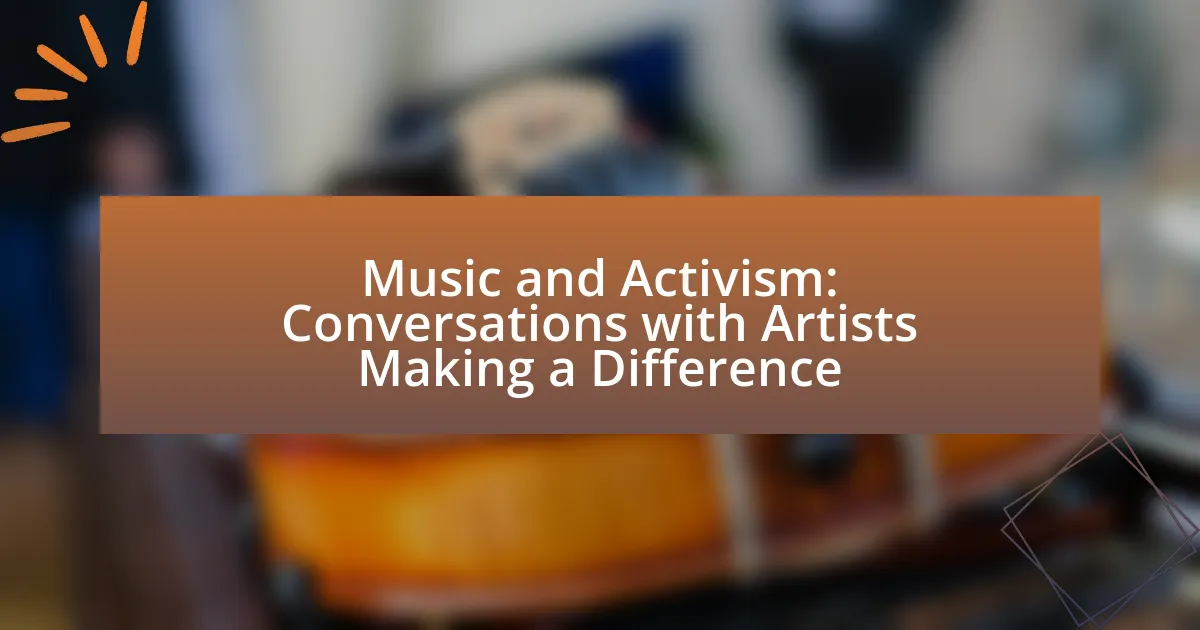The article explores the intrinsic relationship between music and activism, highlighting how artists utilize their platforms to drive social change and political expression. It examines historical and contemporary examples of music as a tool for activism, including iconic songs and movements that have shaped public discourse. The discussion includes the role of different music genres in activism, the personal motivations behind artists’ engagement, and the impact of community and collaboration on social movements. Additionally, it addresses the challenges artists face in balancing their careers with activism and the effectiveness of music-driven campaigns in promoting awareness and inspiring action.

What is the relationship between music and activism?
Music and activism are intrinsically linked as music serves as a powerful tool for social change and political expression. Throughout history, artists have used music to raise awareness about social issues, mobilize communities, and inspire action. For example, during the Civil Rights Movement in the United States, songs like “We Shall Overcome” became anthems that united activists and conveyed messages of hope and resistance. Additionally, contemporary artists such as Billie Eilish and Kendrick Lamar address issues like climate change and racial inequality in their music, further demonstrating how music can amplify activist messages and foster collective action.
How has music historically been used as a tool for activism?
Music has historically been used as a tool for activism by conveying messages of social justice, resistance, and change. For example, during the Civil Rights Movement in the United States, songs like “We Shall Overcome” became anthems that united activists and inspired collective action against racial segregation and discrimination. Additionally, protest songs from artists such as Bob Dylan and Joan Baez highlighted issues like war and inequality, galvanizing public sentiment and encouraging political engagement. The use of music in these contexts demonstrates its power to mobilize communities, raise awareness, and foster solidarity among individuals fighting for a common cause.
What are some key examples of music influencing social change?
Music has significantly influenced social change through various movements and iconic songs. For instance, “Fight the Power” by Public Enemy became an anthem for the civil rights movement in the late 1980s, addressing racial inequality and injustice. Similarly, Bob Dylan’s “The Times They Are a-Changin'” served as a rallying cry during the 1960s counterculture and civil rights movements, encouraging societal transformation. Additionally, the song “Alright” by Kendrick Lamar emerged as a powerful message of hope and resilience during the Black Lives Matter movement, symbolizing the struggle against police brutality and systemic racism. These examples illustrate how music has been a catalyst for social awareness and activism, shaping public discourse and inspiring collective action.
How do different genres of music contribute to activism?
Different genres of music contribute to activism by providing a platform for social and political messages, mobilizing communities, and inspiring action. For instance, folk music has historically been associated with protest movements, as seen in the 1960s civil rights movement where artists like Bob Dylan used their songs to address issues of inequality and injustice. Similarly, hip-hop has emerged as a powerful voice for marginalized communities, with artists like Kendrick Lamar addressing systemic racism and police brutality in their lyrics. Rock music has also played a significant role in activism, exemplified by bands like U2, which have used their global reach to advocate for human rights and social change. These genres not only raise awareness but also foster a sense of solidarity among listeners, encouraging them to engage in activism.
Why do artists choose to engage in activism through their music?
Artists choose to engage in activism through their music to amplify social and political messages that resonate with their audience. This engagement allows them to raise awareness about critical issues such as inequality, climate change, and human rights. For instance, musicians like Bob Dylan and Public Enemy have historically used their platforms to address social injustices, influencing public opinion and inspiring movements. Research indicates that music can effectively mobilize communities and foster solidarity, making it a powerful tool for activism.
What personal experiences drive artists to become activists?
Personal experiences that drive artists to become activists often include encounters with social injustice, personal trauma, or significant life events that shape their worldview. For instance, artists who have faced discrimination or inequality may feel compelled to use their platform to advocate for change. Historical examples include musicians like Bob Dylan, whose experiences during the civil rights movement influenced his songwriting and activism. Additionally, artists may be motivated by witnessing the struggles of their communities, prompting them to address issues such as poverty, racism, or environmental concerns through their art. These experiences not only inform their creative expression but also galvanize them to engage in activism, making their work a vehicle for social change.
How does public perception affect artists’ activism efforts?
Public perception significantly influences artists’ activism efforts by shaping the reception and impact of their messages. When the public views an artist positively, their activism is more likely to resonate and mobilize support, as seen with artists like Beyoncé and her advocacy for racial equality, which gained traction due to her widespread popularity. Conversely, negative public perception can hinder an artist’s ability to effect change, as demonstrated by instances where artists faced backlash for their political statements, leading to diminished influence. Thus, the way the public perceives an artist directly correlates with the effectiveness and reach of their activism initiatives.
What role does community play in music and activism?
Community plays a crucial role in music and activism by fostering collaboration, amplifying voices, and creating a shared sense of purpose. Through collective efforts, communities unite around social issues, using music as a powerful tool for expression and mobilization. For instance, during the Civil Rights Movement, musicians like Nina Simone and Bob Dylan used their platforms to address racial injustice, rallying communities to advocate for change. This historical context illustrates how music can serve as a catalyst for community engagement and activism, reinforcing the idea that collective action is essential for driving social progress.
How do local movements utilize music to amplify their message?
Local movements utilize music to amplify their message by creating an emotional connection and fostering community engagement. Music serves as a powerful tool for storytelling, allowing movements to convey their struggles, aspirations, and calls to action in a relatable manner. For instance, protest songs have historically galvanized support during civil rights movements, such as “We Shall Overcome,” which became an anthem for social justice in the 1960s. Additionally, local artists often perform at community events, using their platforms to raise awareness and inspire collective action, as seen in the rise of folk music during the anti-war protests. This integration of music not only enhances visibility but also strengthens solidarity among participants, making the movement’s message more resonant and impactful.
What impact does collaboration among artists have on activism?
Collaboration among artists significantly enhances activism by amplifying messages and fostering a sense of community. When artists unite, they combine diverse perspectives and talents, creating more impactful and resonant works that can reach wider audiences. For instance, the collaboration between musicians and visual artists during movements like Black Lives Matter has resulted in powerful multimedia campaigns that effectively communicate social justice issues. This synergy not only raises awareness but also mobilizes supporters, as seen in events like benefit concerts that draw large crowds and generate substantial funds for causes. Such collaborations demonstrate that collective creativity can drive social change and inspire action.

How do artists make a difference through their music?
Artists make a difference through their music by addressing social issues, inspiring change, and fostering community engagement. For instance, musicians like Bob Dylan and Kendrick Lamar have used their lyrics to highlight civil rights and social justice, influencing public opinion and sparking movements. Research shows that music can evoke emotional responses, making it a powerful tool for raising awareness and mobilizing action. A study published in the Journal of Music Therapy found that music can enhance empathy and social connection, further demonstrating its impact on societal change.
What strategies do artists use to raise awareness for social issues?
Artists use various strategies to raise awareness for social issues, including creating impactful art, engaging in public performances, and leveraging social media platforms. For instance, visual artists often produce works that highlight specific social injustices, such as street art that addresses systemic racism or inequality, effectively reaching a broad audience. Musicians frequently incorporate social themes into their lyrics and performances, using concerts as platforms for activism, as seen in events like Live Aid, which raised funds and awareness for famine relief in Ethiopia. Additionally, artists utilize social media to amplify their messages, sharing their work and engaging with followers to foster discussions around critical issues, exemplified by campaigns like #BlackLivesMatter, which gained traction through artistic contributions. These strategies not only inform the public but also inspire action and solidarity within communities.
How effective are music festivals and concerts in promoting activism?
Music festivals and concerts are highly effective in promoting activism, as they create a platform for social issues to reach a broad audience. Events like Coachella and Glastonbury have featured campaigns for climate change, racial equality, and mental health awareness, engaging attendees through performances and discussions. For example, the 2019 Glastonbury Festival included a significant focus on climate activism, with Greta Thunberg addressing the crowd, which amplified the message to thousands of attendees and millions more through media coverage. This demonstrates that music events can mobilize communities, raise awareness, and inspire action on critical social issues.
What role does social media play in artists’ activism efforts?
Social media serves as a crucial platform for artists’ activism efforts by enabling them to reach a global audience instantly. Through platforms like Twitter, Instagram, and Facebook, artists can share their messages, mobilize supporters, and raise awareness about social issues. For instance, during the Black Lives Matter movement, numerous musicians utilized social media to amplify their voices, share resources, and encourage their followers to participate in protests. This direct engagement allows artists to influence public opinion and foster community action, demonstrating the significant impact of social media in contemporary activism.
How do artists balance their careers with activism?
Artists balance their careers with activism by integrating their creative work with social causes, often using their platforms to raise awareness and inspire change. Many artists strategically choose projects that align with their values, allowing them to advocate for issues while maintaining their artistic integrity. For instance, musicians like Billie Eilish and Chance the Rapper have successfully combined their music careers with activism, addressing topics such as climate change and social justice through their lyrics and public statements. This dual focus not only enhances their artistic expression but also engages their audiences in meaningful conversations, demonstrating that art can be a powerful tool for activism.
What challenges do artists face when integrating activism into their work?
Artists face several challenges when integrating activism into their work, primarily including the risk of alienating audiences, potential backlash from stakeholders, and the difficulty of balancing artistic expression with political messaging. The need to maintain commercial viability often conflicts with the desire to address controversial issues, leading to a tension between artistic integrity and market demands. Additionally, artists may encounter censorship or limitations imposed by institutions, which can hinder their ability to fully express their activist messages. For instance, a study by the National Endowment for the Arts highlights that artists frequently navigate complex social landscapes where their work can provoke strong reactions, impacting their careers and public perception.
How can artists maintain authenticity while advocating for causes?
Artists can maintain authenticity while advocating for causes by aligning their personal values with the causes they support. This alignment ensures that their advocacy feels genuine and resonates with their audience. For instance, artists like Billie Eilish have openly discussed mental health issues, drawing from their own experiences, which enhances their credibility and connection with fans. Research indicates that authenticity in artistic expression can lead to greater audience engagement, as seen in studies published in the Journal of Personality and Social Psychology, which highlight the positive impact of personal storytelling in art. By sharing their own narratives and experiences related to the causes they champion, artists can effectively advocate while remaining true to themselves.
What are the measurable impacts of music-driven activism?
Music-driven activism has measurable impacts that include increased awareness of social issues, mobilization of communities, and changes in public policy. For instance, campaigns like “Rock the Vote” have successfully registered millions of young voters, demonstrating a direct correlation between music initiatives and electoral participation. Additionally, events such as Live Aid raised over $125 million for famine relief in Ethiopia, showcasing how music can generate significant financial support for humanitarian causes. Research indicates that music can enhance emotional engagement, leading to greater advocacy and action among listeners, as evidenced by studies linking protest songs to heightened social movement participation.
How can we assess the effectiveness of an artist’s activism?
The effectiveness of an artist’s activism can be assessed through measurable impacts on social change, audience engagement, and public discourse. For instance, analyzing changes in public policy or community behavior following an artist’s campaign can provide concrete evidence of influence. Additionally, metrics such as social media engagement, attendance at activist events, and fundraising success for causes can serve as indicators of an artist’s reach and effectiveness. Studies, such as those conducted by the Pew Research Center, have shown that artists can significantly shape public opinion and mobilize communities, further validating the assessment of their activism through these tangible outcomes.
What long-term changes have resulted from music activism campaigns?
Music activism campaigns have led to significant long-term changes in social awareness and policy reform. For instance, campaigns like Live Aid in the 1980s raised awareness about famine in Ethiopia, resulting in increased international aid and policy shifts towards humanitarian assistance. Additionally, movements such as the Black Lives Matter initiative have utilized music to amplify messages of racial justice, contributing to ongoing discussions and legislative changes regarding police reform and systemic racism. These campaigns have not only mobilized public support but have also influenced cultural narratives, leading to a more engaged and informed society regarding social issues.

What are some notable examples of artists making a difference?
Notable examples of artists making a difference include Beyoncé, who has used her platform to advocate for racial equality and women’s rights, particularly through her visual album “Lemonade” and her involvement in the Black Lives Matter movement. Another example is Chance the Rapper, who has significantly contributed to education reform in Chicago by donating millions to public schools and advocating for funding. Additionally, Billie Eilish has raised awareness about climate change through her music and public statements, aligning her tours with environmental initiatives. These artists demonstrate the impactful role of musicians in social activism, using their influence to drive change and inspire their audiences.
Who are some influential artists known for their activism?
Some influential artists known for their activism include Beyoncé, who advocates for racial equality and women’s rights, and Kendrick Lamar, who addresses social justice issues through his music. Additionally, artists like Joan Baez and Bob Dylan have historically used their platforms to promote civil rights and anti-war movements. Their activism is evident in their lyrics and public statements, which often reflect their commitment to social change and justice.
What specific causes have these artists championed?
Artists have championed various specific causes, including social justice, environmental sustainability, mental health awareness, and racial equality. For instance, musicians like Billie Eilish advocate for climate action through initiatives like “Sustainable Music,” while artists such as Kendrick Lamar focus on racial justice and police brutality, as highlighted in his song “Alright.” Additionally, Lady Gaga has been a prominent advocate for mental health awareness, founding the Born This Way Foundation to support youth mental health initiatives. These examples illustrate the diverse range of social issues that artists actively support through their platforms and music.
How have their contributions shaped public discourse?
Contributions from artists in the realm of music and activism have significantly shaped public discourse by raising awareness on social issues and influencing cultural narratives. For instance, musicians like Bob Dylan and Kendrick Lamar have used their platforms to address topics such as civil rights and systemic racism, respectively, prompting public conversations and mobilizing communities. The impact of their work is evidenced by the widespread adoption of their messages in protests and social movements, such as the Black Lives Matter movement, where songs like “Alright” by Kendrick Lamar became anthems for change. This integration of music and activism not only amplifies marginalized voices but also fosters a collective consciousness around pressing societal issues, thereby transforming public discourse.
What lessons can be learned from successful music activism campaigns?
Successful music activism campaigns demonstrate the importance of authenticity and community engagement. Authenticity resonates with audiences, as seen in campaigns like Live Aid, which raised over $125 million for famine relief in Ethiopia, showcasing how genuine artist involvement can mobilize public support. Additionally, community engagement is crucial; for instance, the “Rock the Vote” initiative effectively increased voter registration among young people by leveraging popular music and artists to connect with the demographic. These campaigns illustrate that aligning music with social causes can amplify messages and drive meaningful change.
What best practices can emerging artists follow in their activism?
Emerging artists can enhance their activism by leveraging their platforms to raise awareness about social issues, engaging with their communities, and collaborating with established organizations. By using their music and art to address topics such as climate change, racial equality, or mental health, they can reach diverse audiences and inspire action. For instance, artists like Billie Eilish have effectively used their influence to advocate for environmental sustainability, demonstrating that music can be a powerful tool for social change. Additionally, participating in local events and initiatives allows artists to connect directly with their audience, fostering a sense of community and shared purpose. Collaborating with nonprofits or social movements can also amplify their message and provide resources for effective activism.
How can artists effectively engage their audience in activism?
Artists can effectively engage their audience in activism by utilizing their creative platforms to raise awareness and inspire action on social issues. Through music, visual art, and performance, artists can convey powerful messages that resonate emotionally with their audience, fostering a sense of connection and urgency. For instance, musicians like Billie Eilish and Kendrick Lamar have used their lyrics to address topics such as climate change and racial inequality, prompting listeners to reflect and take action. Research indicates that emotional engagement through art can lead to increased activism; a study published in the Journal of Social Issues found that individuals exposed to art related to social causes are more likely to participate in activism themselves. This demonstrates that artists, by leveraging their influence and creativity, can mobilize their audiences towards meaningful change.
What resources are available for artists interested in activism?
Artists interested in activism can access various resources, including organizations, grants, and online platforms that support activist art. Notable organizations such as the Creative Capital Foundation provide funding and professional development for artists engaged in social change. Additionally, the National Endowment for the Arts offers grants specifically aimed at projects that address community issues through artistic expression. Online platforms like Artivism and the Activist Artist Network connect artists with like-minded individuals and provide tools for collaboration and advocacy. These resources empower artists to amplify their voices and contribute meaningfully to social movements.
How can artists connect with organizations that support their causes?
Artists can connect with organizations that support their causes by actively engaging in networking opportunities, utilizing social media platforms, and participating in community events. Networking at industry conferences, workshops, and local art shows allows artists to meet representatives from organizations aligned with their values. Social media platforms, such as Instagram and Twitter, provide artists with the ability to showcase their work and causes, attracting the attention of organizations looking for partnerships. Additionally, participating in community events, such as fundraisers or awareness campaigns, enables artists to collaborate directly with organizations, fostering relationships that can lead to ongoing support and advocacy.
What tools can artists use to amplify their activism through music?
Artists can use social media platforms, streaming services, and live performances to amplify their activism through music. Social media platforms like Instagram and Twitter allow artists to share their messages and engage with audiences directly, fostering community and awareness around social issues. Streaming services such as Spotify and Apple Music provide artists with the ability to reach global audiences, enabling them to distribute songs that address activism themes widely. Live performances, including benefit concerts and virtual events, create opportunities for artists to raise funds and awareness for causes they support, exemplified by events like Live Aid and the Global Citizen Festival, which have successfully mobilized resources for various humanitarian efforts.
